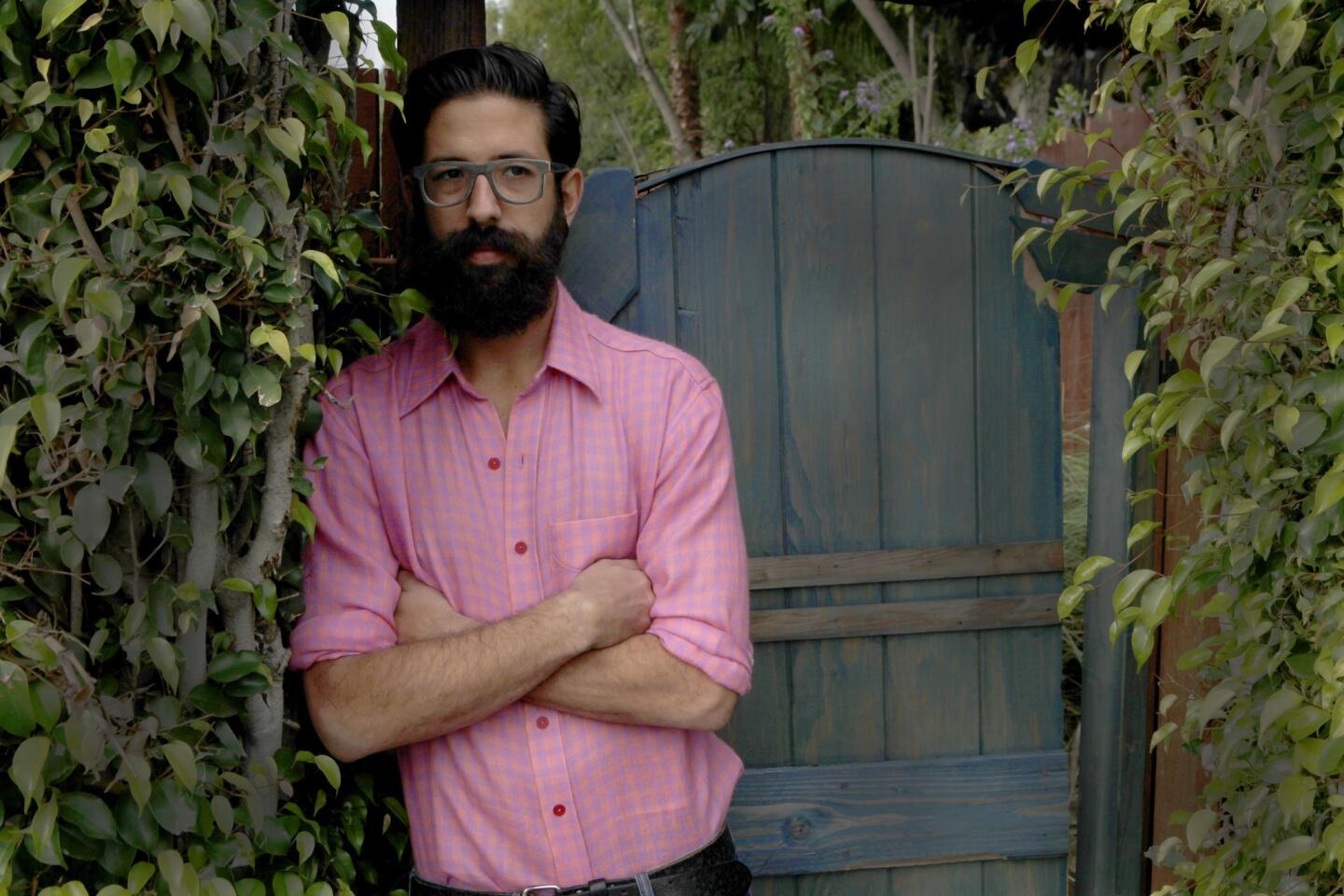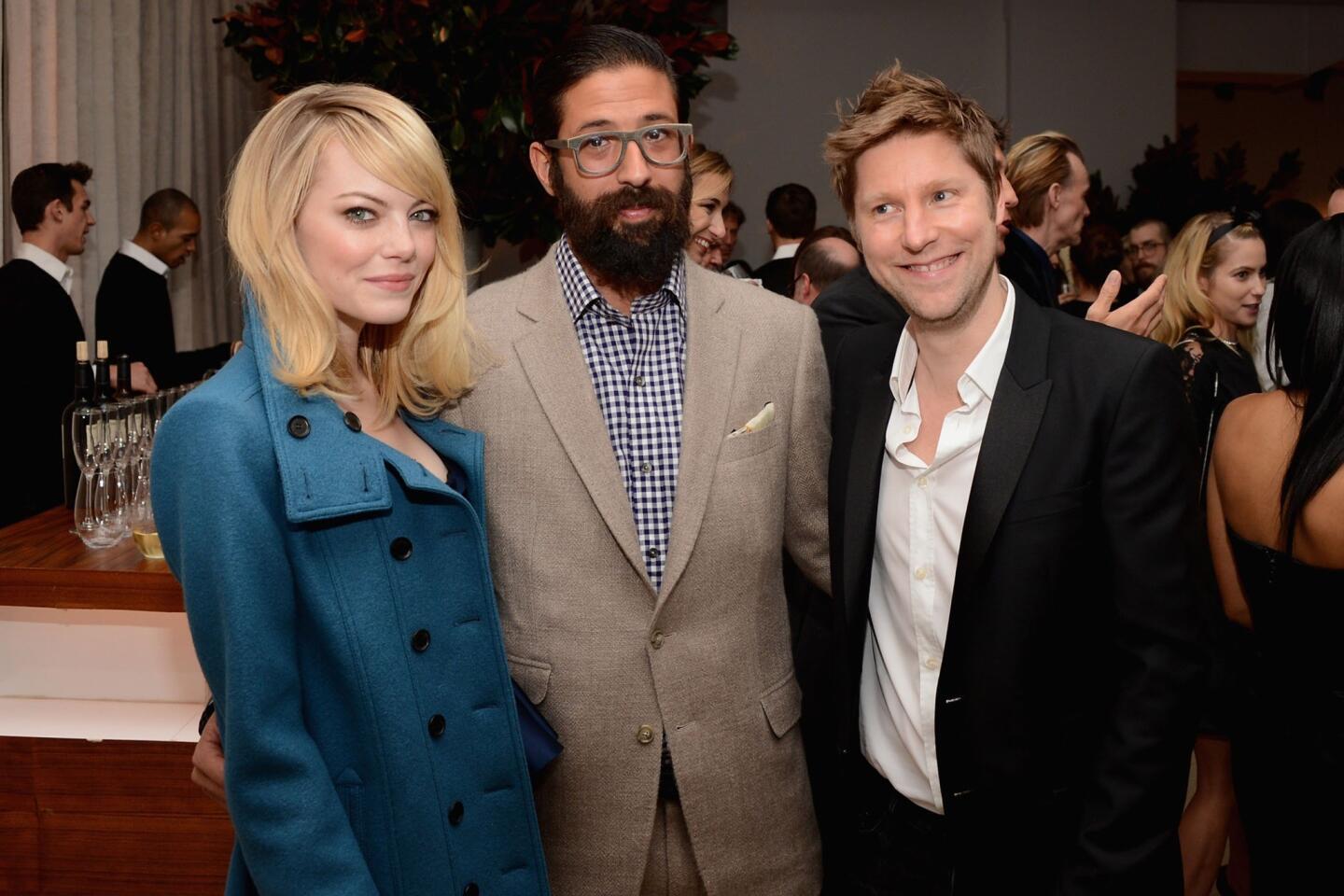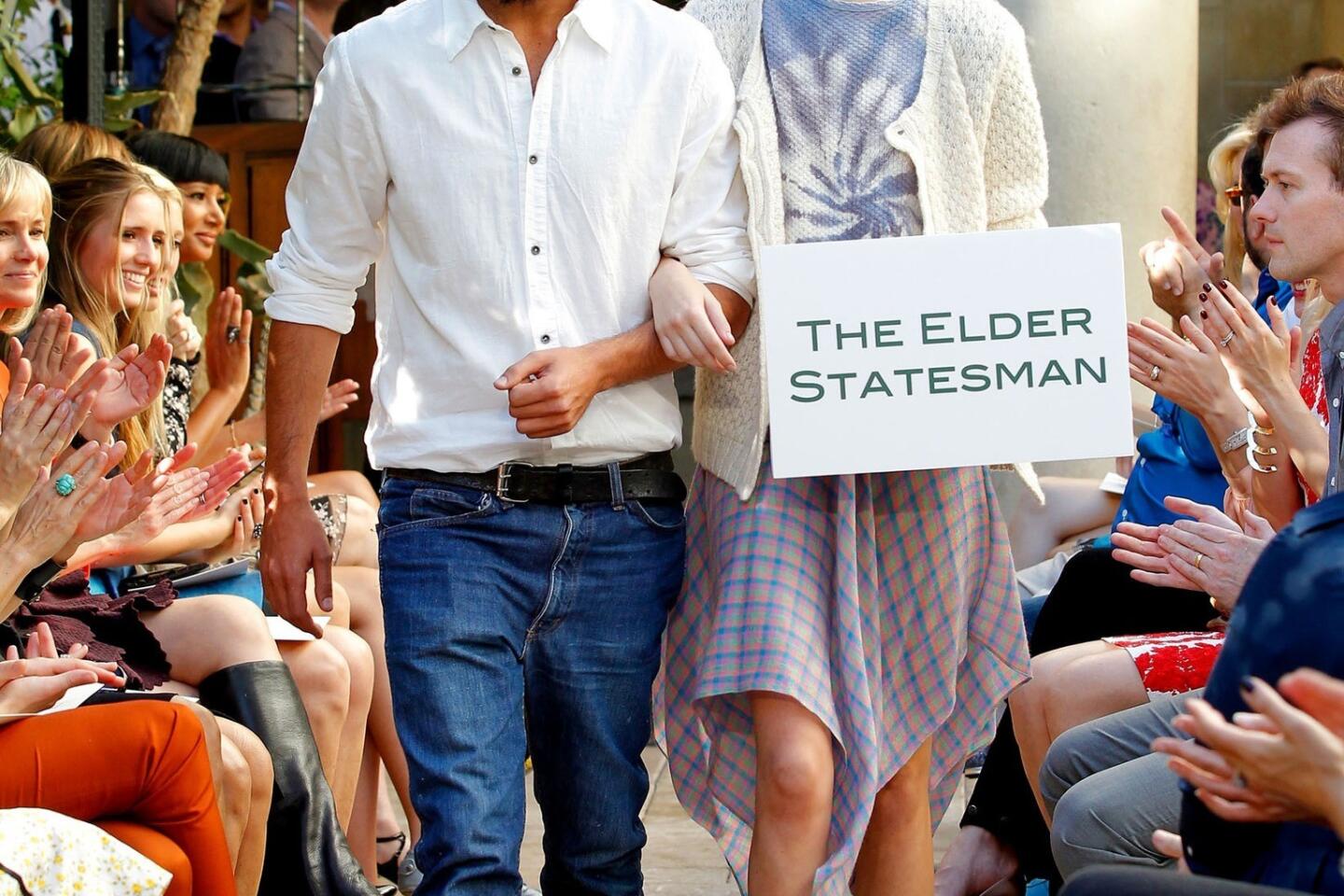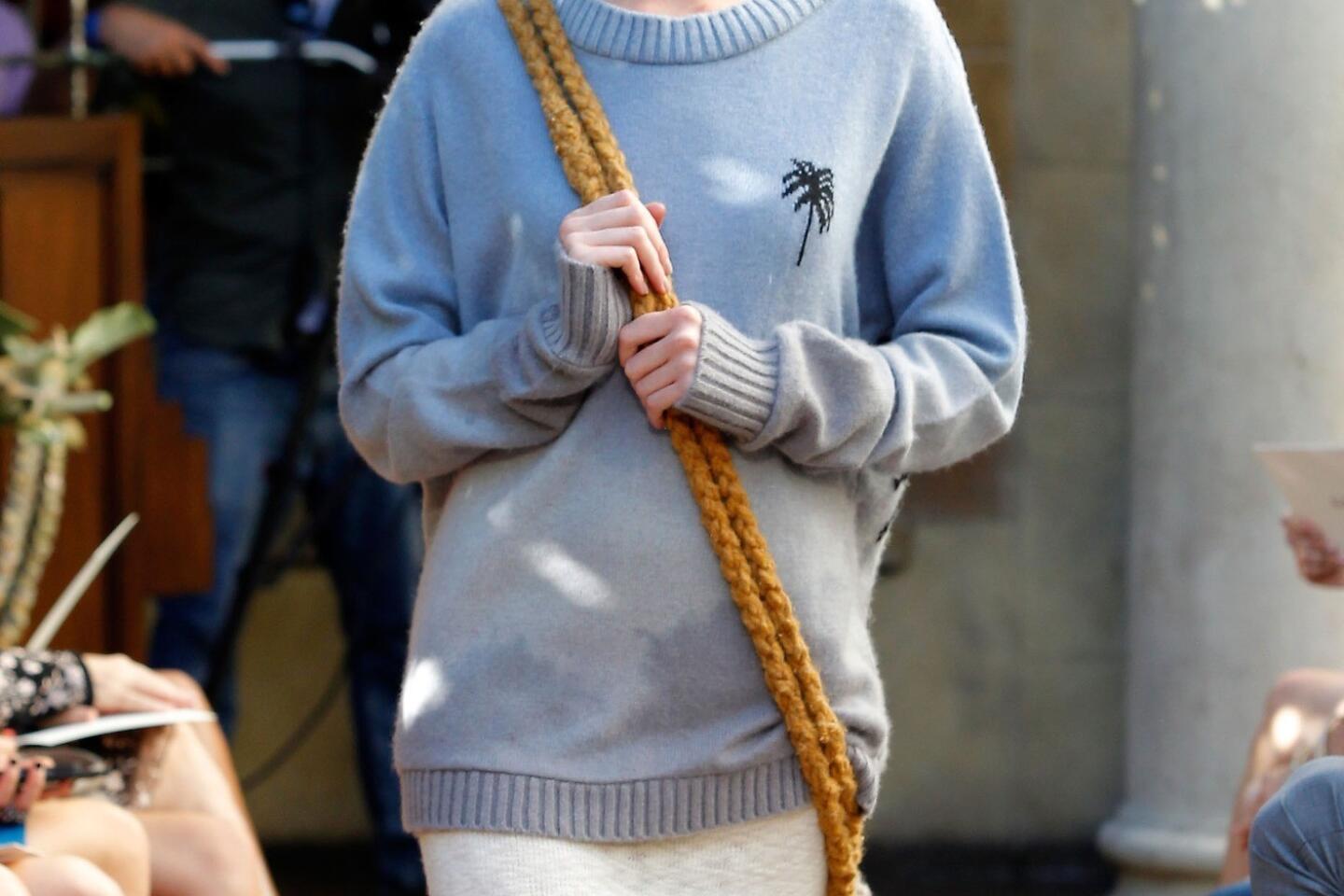Designer Greg Chait: Ready for his close-up?
- Share via
When Greg Chait won the CFDA/Vogue Fashion Fund Award in New York City last month, the man behind the Elder Statesman line of ultra-luxury cashmere knits — think $5,525 blankets, $1,890 belted cardigan sweaters and $380 ski caps — was practically unknown outside the fashion industry. And he was only slightly better known within it.
“That’s because I don’t talk unless I have something to say,” Chait says, sitting behind the wooden table that doubles as a desk in his tiny West Hollywood office/atelier — the exact location of which he’d rather not divulge. “I want the stuff to speak for itself.”
There are other reasons too. Among them are the label’s relatively small distribution — it’s carried by only about 60 retail accounts worldwide — and the fact that the 5-year-old brand is based in Los Angeles, far from New York City’s fashion fishbowl.
In many ways, the Elder Statesman is the kind of brand that could only come from L.A. That’s not just because this is the city that popularized women’s cashmere track suits for everyday wear and where dudes can be seen rocking knit caps in 90-degree weather. It’s also because it’s similar to high-end craftsy/cottagey niche labels such as Rodarte, George Esquivel and Gregory Parkinson that have come out of Los Angeles the last few years.
The biggest reason Chait and the Elder Statesman have flown well below the radar has to do with the collection itself — a range of high-end, artisanal slouchwear that includes things like slubby, striped Baja hoodies crafted from hand-spun cashmere, plaid pashmina button-front workshirts, chunky knit Rasta caps, clingy long-sleeve T-shirts, simple sweater dresses and pullovers with intarsia palm tree designs.
All of it is made in the U.S. — mostly by a network of 20 to 30 hand knitters clustered in the L.A. area — from super-soft, hand-spun cashmere yarns that hail from far-flung places including Mongolia, India, Italy, Scotland and Peru. These are the kind of clothes that feel like a million bucks on the body, look like a modest 25 to 100 bucks from across the room but will easily set you back a month’s rent.
It’s such an understated approach to high-end covetables that calling it “stealth luxury” hardly does it justice. What Chait’s created is nothing short of “black ops luxe.”
Steven Kolb, chief executive of the Council of Fashion Designers of America (and one of the Fashion Fund judges) says that’s part of the brand’s appeal.
“It’s a basic luxury item that, on first glance, could be anything,” he says. “But when you take a closer look, you touch it, put it on, you appreciate the level of quality that went into it. That [the pieces] look like basics from a distance but have that subtle richness and specialness is what I think makes it appealing.”
Now, thanks to winning the CFDA/Vogue Fashion Fund Award, Chait is firmly on the radar. The award program, now in its ninth year, was created by the Council of Fashion Designers of America and Vogue magazine to incubate emerging talent, and its top honor includes a $300,000 cash prize and a yearlong industry mentorship. In addition, two runners-up (this year they were New York-based shoe designer Tabitha Simmons and L.A. jewelry designer Jennifer Meyer Maguire) each receive $100,000 and a year of business mentoring.
Here comes the spotlight
Beyond affording the opportunity to take a brand to the next level, the award brings with it all kinds of media exposure (the pages of Vogue magazine for example) and additional retail opportunities, such as the new CFDA/Vogue Fashion Fund pop-up shops that are slated to open in five Nordstrom stores in February.
But exactly who is this bearded cipher? Where did he come from? And, in an era of fast fashion and cheap chic, where cashmere can be bought at Costco, how did this riddle wrapped in an enigma and shrouded in cashmere raise the bar and become the least-known darling of the fashion industry elite?
Currently living in Malibu with his fiancee (actress Laura Ramsey) and their 3-year-old daughter, the 34-year-old Chait (rhymes with “eight”) was born in Toronto to South African expats. By the time he was 1, the family had relocated to Arizona. He credits a doctor father and artist mother with teaching him to be inquisitive and encouraging him to explore the world.
And explore he did, attending four colleges on two continents (and squeezing in a summer internship for Whitney Houston) before finishing at the University of Arizona, where he cobbled all his disparate credits together for a self-made major called “Communications for the Entertainment Industry.”
After post-graduation plans to spend a year working (and surfing) in Australia were cut short, Chait moved to Los Angeles and landed a job at an on-the-rise artist and talent management company called the Firm.
His Down Under surfing safari ended up being key to his future career, though, since it was there he became friends with the founders of the Tsubi (later Ksubi) Australian denim brand.
After a visit to L.A., the Tsubi guys left him with a suitcase full of blue jeans, which he peddled around town. By 2004, he’d left the Firm and signed on full-time as CEO of Tsubi North America, a position he held for three years. (Along the way, he briefly dated Ashley Olsen, who with her twin sister Mary-Kate, was in the process of making her own foray into high-end fashion with the launch of the Row.)
In 2007, Chait sold his shares and left Ksubi (a trademark dispute had forced the label to change the spelling) amid a business restructuring. He planned to make a fleet of mobile juice trucks his next venture until fate intervened in the form of a cashmere blanket given to him by a friend.
“This is the blanket that started it all, this little fella,” he says, smoothing a brown, 50-by-70-inch pashmina-thin blanket out on the desk with something approaching reverence. “This is what started my obsession with cashmere straight away.”
Like Diogenes looking for one honest man, Chait spent years scouring the globe in search of a single, perfect, cashmere blanket. He found blankets that were too small, too thin or too ordinary. Eventually, his cashmere quest led him to one conclusion: He needed to start at the beginning — with the yarn itself.
A friend introduced him to a company in the Pacific Northwest (he won’t name the company or even the town), which custom-made him two 59-by-79-inch hand-knit blankets out of heavy-gauge, hand-spun cashmere yarn. The resulting blankets — which tipped the scales at 10 pounds apiece — made that first cashmere blanket look like a fistful of brown tissue paper by comparison. He had, in his estimation, created the ideal cashmere blanket.
Utilitarian yet luxurious
“With hand-spun yarn you can really control the thickness,” he explains, “and the end result is something that looks really masculine and utilitarian but is this ultimate luxury.”
In late 2007, Chait took them to Maxfield, whose buyers he knew from his Ksubi days, and sold both $6,000 blankets on the spot. “Then they said: ‘How many do you think you can have by Christmas?’” Chait recalls. “I was able to get seven more blankets and a couple of these traditional toques.”
At this point, Chait says, he hadn’t even named his line. He chose the name the Elder Statesman, he says, as a homage to his older brother Paul, who had died in a 2004 shooting in Phoenix. “He was one of those kind of guys that everybody called ‘the mayor,’” Chait said.
In early 2008 he decamped to a Paris hotel suite during Fashion Week and sold his fledgling collection of sweaters, hats and blankets to a handful of high-end accounts around the world including United Arrows in Tokyo, Barneys New York, A’Maree’s of Newport Beach and the influential Susan boutique in San Francisco.
“It was such an excitement to see someone who was really excited and passionate about his product,” recalls Susan’s owner, Susan Foslien. “Honestly, it’s what’s missing in our industry — that spontaneous, infectious feeling. And what he does is authentic — I mean he makes his own damn yarn, come on! Everybody’s sick of all that stuff that has no meaning.”
Foslien described the Elder Statesman customer as “an intellectual. She’s smart, she doesn’t give a crap about who’s wearing the latest Balenciaga dress because she’s got 10 anyway, so it doesn’t matter. She doesn’t care about all that stuff we’re supposed to care about.’”
Foslien sees the brand’s relatively low profile as an asset. “Because it’s a little bit hidden, people come into the store and put on one of his sweaters that’s rather expensive, and they say: ‘Oh, I’ll take this.’”
Even as his business has grown to include some 60 retail accounts across the globe, including luxury boutiques stockists such as Louis Boston, Hostem in London and Boon the Shop in Seoul, Chait says he’s worked hard to maintain stealth status and exclusivity. “I’ve been very careful about my distribution, I’m still just in Maxfield [in L.A] and L’Éclaireur in Paris, and I have just one online retailer — Mr. Porter for men and Net-a-Porter for women.”
Tyro by tes
In November 2011, Chait added a smaller, more affordable capsule collection to the mix: an assortment of fingerless gloves, knit caps, scarves and zip-front hoodies that sells for between $150 and $695 (due, in part to substituting baby alpaca for the Mongolian cashmere and having the pieces hand-knit in Peru instead of the U.S.). That line, called Tyro by tes (“tyro” is a Latin word that means novice or beginner, and the “tes” is short for “the Elder Statesman”) sells exclusively through Barneys New York.
In addition, he says he does a substantial custom business (the pillows and blankets in the SoHo House West Hollywood screening room are his) that accounts for 30% of sales — though, like much else about his business, he won’t share, even in the broadest terms, what those sales are.
Kolb thinks the Elder Statesman can become a big luxury brand. “We’re always looking at business potential as well as talent,” Kolb said. “And having talked with Greg, having visited his studio and listened to his vision of how he wants to grow the Elder Statesman, I think played into his winning the [award].
“He’s got money now, he can invest in staff, he’s basically been a one-man show out there, so now in addition to [being in] these great men’s stores he can invest in people power. I think that’ll be helpful to him as he grows the business.”
And that’s exactly what Chait has been doing — starting with the hiring of a controller/chief financial officer the day after he won (“She literally started two days later,” he says), interviewing designers by Week 2 (“I’m bringing someone in who is more technically trained than I am”) and, by Week 3, opening his first factory, a 3,000-square-foot space in Culver City that will house hand looms and the production of one-off custom pieces.
Chait says he’s excited to embark on his yearlong mentorship. He’s been paired with Richard and Laurie Stark, whose Los Angeles based Chrome Hearts jewelry and accessories line shares a similar double helix of near nose-thumbing exclusivity and full-immersion lifestyle branding. And, Chait says, he’s optimistic about the halo effect of winning the CFDA/Vogue award.
But don’t expect Chait to make any radical departures from his super-stealth, slow-growth, ultra-luxe approach.
“I’m going to continue on the trajectory I’d already planned,” he says. “This gives me a little more confidence, it creates a little more affirmation in the marketplace and it gives me the right opportunity to tell my story ... [but] I like the allure of a brand where you don’t really know [much about it]. I like that quietness.”











